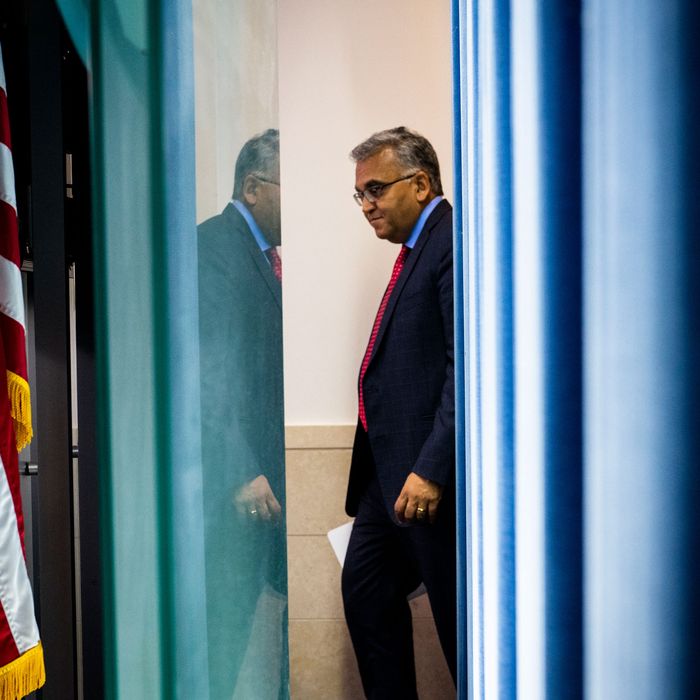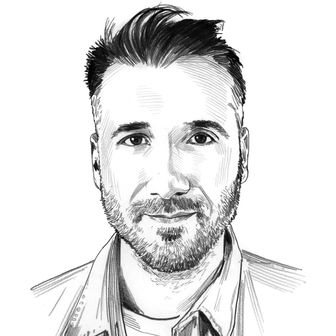
Dr. Ashish Jha walked into one of the Eisenhower Executive Office Building’s most ornate reception rooms in late July and took to the podium to address a group of biotech executives, government officials, public-health experts whose Twitter followings have hockey-sticked over the past two years, as well as thousands of people streaming live online. Jha knew many of the people in the room from his life before he became President Biden’s COVID-19 Response Coordinator in April, and he had invited them to talk about the future of vaccines. “Why do we need something different?” he asked once everyone had settled into their seats. “The vaccines we have are terrific, but we can do better than that. In fact, I believe we have to do better.”
Most of the summit’s guests and panelists wore masks, which made recognizing them by their Twitter avatars and frequent appearances on cable news difficult. Luckily, they wore name tags. There was Dr. Céline Gounder of the Kaiser Family Foundation taking a seat near Dr. Megan Ranney from Brown University. Dr. Akiko Iwasaki, the Yale professor, sat on a panel to talk about her nasal-spray research. Dr. Anthony Fauci gave a short PowerPoint presentation after Jha’s introduction. “This is the first time so many of us have actually been in the same room,” observed Dr. Peter Hotez of Baylor College of Medicine, who, despite his mask, was recognizable thanks to his bowtie. (A few months into the pandemic, Hotez told me cable-news watchers began sending him bowties.)
As COVID czar, Jha’s message carries significantly more weight than it did when he was a pandemic-age celebrity, sometimes appearing on television a dozen times in a single day. The summit was the first major indication of his and the Biden administration’s priorities in the pandemic’s third year. He explained that the summit would focus on two scientific advancements he said were within reach: a nasal spray that would make vaccine delivery easier while triggering immune responses where the infection occurs (the nose, mouth, and lungs) and a multivalent vaccine that would prevent infection by multiple variants and transmission of the virus. For many Americans, the first generation of vaccines promised a return to pre-pandemic normalcy that proved fleeting. Jha’s summit, and the scientific advancements it highlighted, previewed the return of that promise.
As Americans stumble through the current, somewhat-difficult-to-define phase of the pandemic, Jha’s decision to invest so much time and energy in yet-to-be-proven vaccines may be puzzling. But so is the country’s immunological and political landscape. Some 78 percent of Americans have received at least one COVID shot and 70 percent have been infected with COVID, a significant portion of whom were vaccinated. While rates of hospitalization and death are far lower than they were when Biden took office, the country is still on track to record 250,000 COVID deaths this year by the end of 2022 — five times the toll of the average flu season — and many Americans have settled into a new normal, accepting surges from variants like Omicron (which killed more than 100,000 people nationwide last winter) and sub-variants like BA.5 as part of everyday life. It’s up to Jha to chart a course through that purgatorial state, careful not to overstate the crisis and make the administration look inept while simultaneously making actual progress in the fight against COVID.
Some experts have gone so far as to call COVID “endemic,” a conclusion with which Jha strongly disagrees. “Normalcy is a spectrum,” he says, sitting in his sparsely decorated West Wing office during the vaccine summit’s lunch break. He’s wearing a blue suit with a purple tie and, at the beginning of our conversation, he apologizes in advance for eating during our interview. (He takes just a single bite from a pickle during our 35 minutes together.) “The virus is not endemic by any rational definition,” he continues. “There will come a time when the virus will settle down and we will have essentially an immunologic kind of détente, where we have really great immunity built up in the population. The virus is still around, but it causes little mini-ripples. People aren’t dying; people aren’t ending up in the hospital in any measurable numbers. And we will get to that point. We’re not there yet.”
There’s no saying how many degrees on the normalcy spectrum separate the current phase from endemic, but Jha is placing a large bet on the new technologies being discussed at today’s summit. “There’s no question in my mind that these next-generation vaccines will not be incremental,” he says. “They will be a leap closer to really getting to a point where most Americans feel normal.”
Jha, 51, was born in one of the poorest states in India. His family moved to Toronto, then to New Jersey when he was a child and didn’t start speaking English until they immigrated to Canada when Jha was 9. As a kid, Jha wanted to be a journalist, though that ambition never progressed past his high-school newspaper. Instead, he studied economics at Columbia and medicine at Harvard. He stuck around Cambridge as a professor and was appointed faculty director of the Harvard Global Health Institute in 2014. In September 2020, he was appointed dean of the Brown University School of Public Health.
When Biden picked Jha to be the incoming COVID czar in March, it surprised many, because Jha hadn’t worked in government and he’d never overseen something as large as a federal response program. But by that point, Jha had established himself as one of the leading COVID communicators — just as likely to appear on conservative outlets as on liberal ones. His appearances on Newsmax segments like the “coronavirus contradiction” series were a lesson in dispassionate fact-checking, batting down false information, and completely ignoring biased or overtly political questions. “They control access to their audience, but they don’t control their bodies,” Jha says. “My only standard that I kept for myself was that you could hear me on Newsmax and you could hear me on MSNBC, and you needed to know it was the same guy giving the same message.”
Jha’s belief in clear communication developed early in the pandemic. In March 2020, as COVID spread across the globe, Jha told his staff at Harvard to drop everything and begin creating a model that assessed the nation’s hospital capacity. The team sent that model to the New York Times rather than to a medical journal (which would have taken ages to publish) and watched as the story was picked up by news outlets across the country. That’s when a realization set in: Communication during a global health crisis shouldn’t be about the response; it is the response. “You want people to change their behaviors and do certain things, so you’ve got to explain it to them,” Jha says.
Jha won’t predict when the vaccines he has staked so much on will be available. He concedes that they won’t be around by the end of this year, but he won’t rule out 2023, which even some of the vaccine summit attendees say is extremely optimistic. “I think the speed with which science and technology can move when you have the concerted effort of the federal government working with industry, working with academia, is extraordinary,” Jha says.
Dr. Peter Hotez has known Jha for years, and he is quick to describe the COVID czar as an expert communicator and consensus builder, yet Hotez is skeptical of the summit’s farsighted approach: “Let’s say, for argument’s sake, we’re talking about 2024. What are we going to do for the next 18 months?” Just as concerning to Hotez is the issue of funding. “One of the messages at the vaccine summit was, ‘Hey, we can think of all the cool stuff we want — intranasal or skin-patch delivery, universal coronavirus vaccines,” he says, “but where’s the money coming from?”
For all of the doom and gloom of the COVID age, one bright spot was the extraordinary speed with which the first generation of vaccines was developed, approved, and distributed. But it was a lot easier to rally support for the first generation of vaccines than it is for the second. While Jha’s predecessors faced raging outbreaks that overwhelmed hospitals, they had urgency on their side. Somewhat paradoxically, lower hospitalization and death rates might have made the job of COVID czar more difficult to spur action. Still, Jha says Biden’s message to him was clear: “Doc, you figure out the public health, and I’ll figure out the politics.” So far, the president has not held up his end of the bargain — Congress has refused to fund new COVID-response initiatives. But Jha is hopeful the summit will gin up funding interest outside the Beltway.
“When the administration signals this is a really important area, I suspect you’ll see the private sector, academics, universities, but also potential funders — private capital — going into these areas as well,” he says. “The goal is to try to catalyze private activity.”
Jha was appointed COVID czar because of his communication skills, but now that he’s settled into the job, he has found that coalition-building, getting executives from Moderna and Pfizer in a room with someone like Hotez (who co-led a team that developed a patent-free, low-cost COVID vaccine), to discuss the future of vaccines is perhaps more important.
“I have virtually no power,” Jha says toward the end of our conversation. “You’ve got to understand people’s views, and values, and why some people want you to do A and other people want you to do B. Some people think that government shouldn’t be involved at all, and other people think the government has got to have a central role. You want to hear that all out, incorporate it, then not just make a decision but have other people feed into that decision — not just because it’s the right way to do things, but it’s actually going to lead to a much more long-term sustainable response.”






























